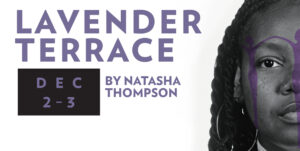PREVIEW: NaTasha Thompson’s Lavender Terrace

Interview: NaTasha Thompson discusses “Lavender Terrace,” a new multimedia interpretation of Marita Bonner’s “The Purple Flower”
By David Bernabo
Lavender Terrace is a multi-media performance that explores Marita Boner’s The Purple Flower, published in 1928. This new play tells the story of marginalized and oppressed people fighting for the right to have life at its fullest over the last eighty years in America. Lavender Terrace progresses through time, beginning in the late twenties and landing in an obscured but familiar representation of the present day.
NaTasha Thompson is a director, playwright, and North Carolina native. Much of her inspiration comes from her southern roots. She creates work that offers opportunity for productive discourse. As a result, underrepresented voices are amplified and education/awareness is increased. NaTasha holds an M.F.A in Directing from Carnegie Mellon University.
Check out our interview with NaTasha Thompson below!
Lavender Terrace premieres at the New Hazlett Theater on December 2, 8PM and December 3, 11AM and 8PM. Click here for tickets and additional information and read up on the New Hazlett Theater’s COVID policies before you attend.
David Bernabo: Hi NaTasha! To start, can you introduce yourself and the piece?
NaTasha Thompson: So my name is NaTasha Thompson. I am the director and playwright for Lavender Terrace. Lavender Terrace is inspired by a play written by Marita Bonner in 1928 called The Purple Flower. The goal for Lavender Terrace is to push her original allegory forward.
DB: Can you tell me a little bit about The Purple Flower and what inspired you to draw from the text?
NT: The Purple Flower, to me, is about Black life in America in the early 20s. Marita was commenting on the changes that were happening in America at the time. You’ve got the migration of Black people coming into the North to acquire better jobs, and at the same time, a lot of rioting happening, a lot of protesting happening. So when the opportunity came to create Lavender Terrace, it felt like the right material to be working on, especially with the protests that were happening last summer and that have been happening for years. It felt like good material to engage with.
DB: The Purple Flower is rather placeless and timeless, right? Are you setting the piece in a place and time?
NT: I’m going off of the period the play was published and produced in. So I’m looking at the late 20s, mid to late 20s to present day. Our goal is to walk through almost 100 years of time. It’s not a chronological 60s, 70s, 80s sort of walk, but just to capture the essence of what Black life has been from the mid to late 20s to present day.
DB: Lavender Terrace, where’s the title come from?
NT: So the original piece is The Purple Flower and the lavender portion is the play off of that. Lavender is the less saturated color. So we may not be as vibrant and as decadent as the original, but we’re still gonna have that essence of The Purple Flower. For Terrace, there was public housing — it wasn’t a project — in North Carolina called Washington Terrace that was renovated and has its own history. And there’s something about landing on that platform of the terrace that I’m playing with the title.
DB: Can you about how the multimedia aspects of the productions play into progressing that timeline?
NT: A lot of Lavender Terrace is about experimenting and using the material as sort of a foundation but also experimenting with different mediums. Projection is going to be used in the piece. We’re using music, we’re using poetry, we’re just using everything we have to tell this story.
